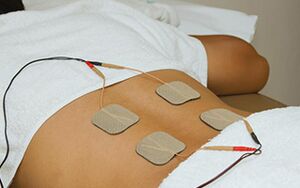Microcurrent Electrical Neuromuscular Stimulation
Introduction[edit | edit source]
Microcurrent Electrical Therapy (MET) is an Electrical intervention indicated for the treatment of pain. By definition microcurrent devices stimulate the affected tissue with less than 1mA of electrical current, most commonly delivered with hand-held probes or self-adhesive electrodes that bracket the treated area. MET is a highly effective modality in the treatment of a variety of pain problems. [1]
A type of low voltage current but with stimulus intensity less than 1 milliamp or 1000 microamps and low intensity stimulation, It is acted at the subsensory or very low sensory level.[2]
Key Points[edit | edit source]
- Microcurrent Electrical Neuromuscular Stimulation (MENS) facilitated the recovery of the relative muscle dry weight, the relative muscle protein content, and the mean cross-sectional areas of muscle fibres of injured Tibialis Anterior muscle in mice.[3]
- The number of satellite cells was increased by MENS during the regenerating phase of injured skeletal muscle.
- MENS facilitated a decrease in the percentages of fibers with central nuclei.
- Facilitate the regeneration of injured skeletal muscles.[4]
Biophysical effects[edit | edit source]
Currents below 500 microamps, applied as low amperage electrical current through the tissues, may stimulate cellular processes that lead to the production of adenosine triphosphate (ATP). This is hypothesized to occur through the influence on ion movement, such as protons, across cellular and mitochondrial membranes, which can affect ATP synthesis within the mitochondria.[3]
Therapeutic effects[edit | edit source]
Promotion of tissue healing[edit | edit source]
Tissue trauma or injury affects the electrical potential of the involved cells which is called injury potential or current of injury and as a result, the bioelectrical activity within the injured area is diminished and the cellular function is disrupted so, re-establishing the body's natural electrical balance which allows cell function and increases ATP supply, thus providing the metabolic energy for healing to occur.[5] Cells are stimulated to increase their normal proliferation, migration, and motility as well as Stimulation of Deoxyribonucleic Acid DNA synthesis and collagen synthesis and increase receptor levels for growth factors.[6]
Analgesic effect[edit | edit source]
Make the nerve cell membrane more receptive to neurotransmitters that will block transmission of pain and create or change the constant direct current flow of the neural tissues that may have some way of biasing the transmission of the painful stimulus then restore the biological electrical balance to facilitate tissues healing and subsequent pain control.[7]
Indications[edit | edit source]
- Acute and chronic pain
- Acute and chronic inflammation
- Sprains
- Strains
- Superficial wound healing
- Fracture healing
- Tendon and ligament healing[8]
Contraindications[edit | edit source]
- Pain of unknown origin or undiagnosed pain
- Osteomyelitis
- Exposed metal implants as in external fixation of fractures.[9]
Neurostimulation Therapy[edit | edit source]
Neurostimulation therapy involves the application of microcurrents to specific body points to alleviate pain and reduce scar tissue, including facial distortions. This therapy, functioning as a non-invasive alternative to acupuncture, aims to relax muscles effectively. It is particularly beneficial for restoring motor control in affected areas and managing post-surgical recovery..[10]
References[edit | edit source]
- ↑ Iijima H, Takahashi M. Microcurrent therapy as a therapeutic modality for musculoskeletal pain: a systematic review accelerating the translation from clinical trials to patient care. Archives of Rehabilitation Research and Clinical Translation. 2021 Sep 1;3(3):100145.
- ↑ Kwon DR, Kim J, Kim Y, An S, Kwak J, Lee S, Park S, Choi YH, Lee YK, Park JW. Short-term microcurrent electrical neuromuscular stimulation to improve muscle function in the elderly: A randomized, double-blinded, sham-controlled clinical trial. Medicine. 2017 Jun;96(26).
- ↑ 3.0 3.1 Ohno Y, Fujiya H, Goto A, Nakamura A, Nishiura Y, Sugiura T, Ohira Y, Yoshioka T, Goto K. Microcurrent electrical nerve stimulation facilitates regrowth of mouse soleus muscle. International journal of medical sciences. 2013;10(10):1286.
- ↑ Fujiya H, Ogura Y, Ohno Y, Goto A, Nakamura A, Ohashi K, Uematsu D, Aoki H, Musha H, Goto K. Microcurrent electrical neuromuscular stimulation facilitates regeneration of injured skeletal muscle in mice. Journal of sports science & medicine. 2015 Jun;14(2):297.
- ↑ Kloth LC, McCulloch JM. Promotion of wound healing with electrical stimulation. Advances in Wound Care: the Journal for Prevention and Healing. 1996 Sep 1;9(5):42-5.
- ↑ Poltawski L, Watson T. Bioelectricity and microcurrent therapy for tissue healing–a narrative review. Physical Therapy Reviews. 2009 Apr 1;14(2):104-14.
- ↑ Korelo RI, Valderramas S, Ternoski B, Medeiros DS, Andres LF, Adolph SM. Microcurrent application as analgesic treatment in venous ulcers: a pilot study. Revista latino-americana de enfermagem. 2012;20:753-60.
- ↑ Davis P. Microcurrent. A modern healthcare modality. Rehab Ther Prod Rev. 1992;10:62-6.
- ↑ Mercola JM, Kirsch DL. The basis for microcurrent electrical therapy in conventional medical practice. Journal of Advancement in medicine. 1995;8(2):107-20.
- ↑ Houghton PE. Clinical trials involving biphasic pulsed current, microcurrent, and/or low-intensity direct current. Advances in wound care. 2014 Feb 1;3(2):166-83.







